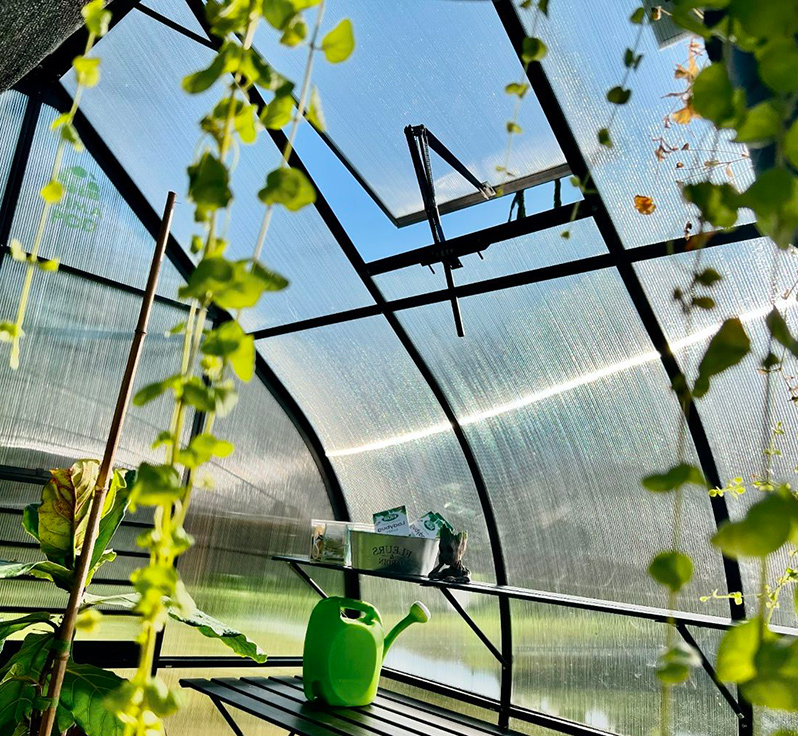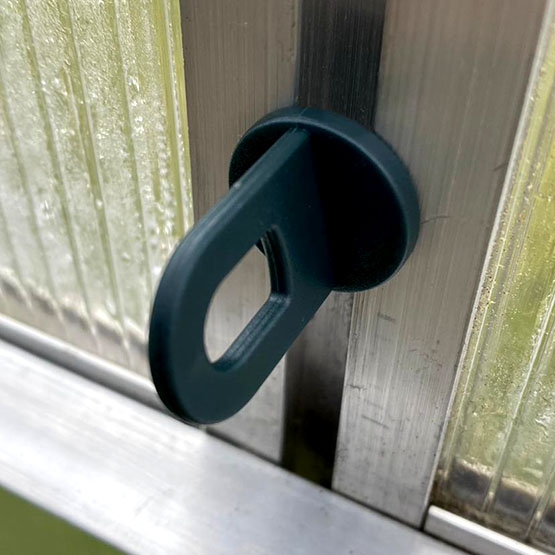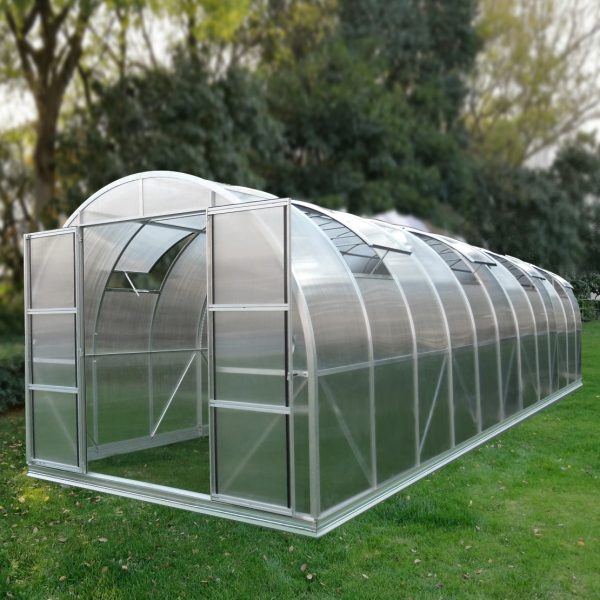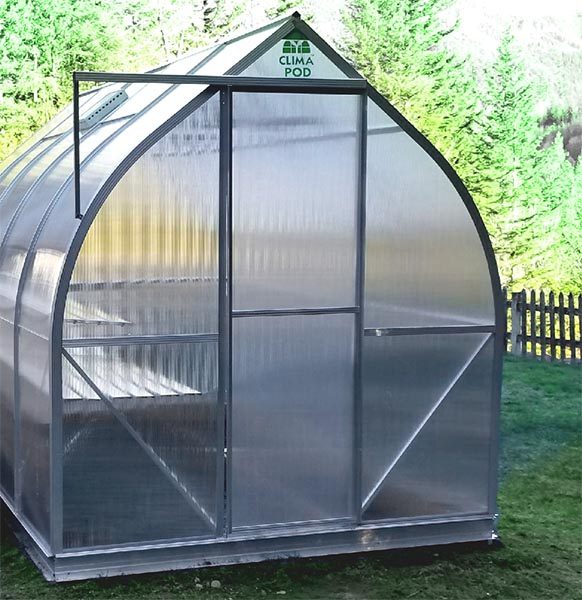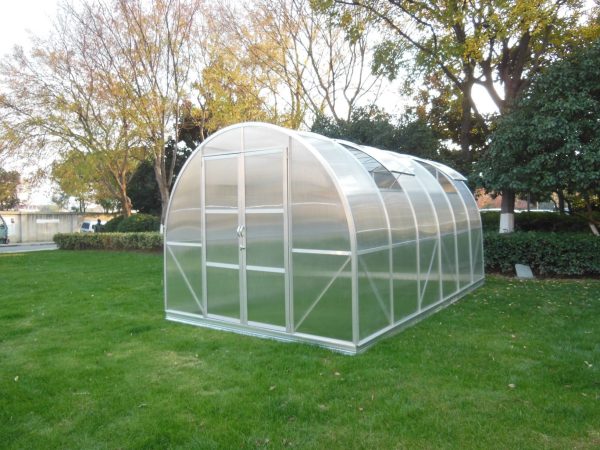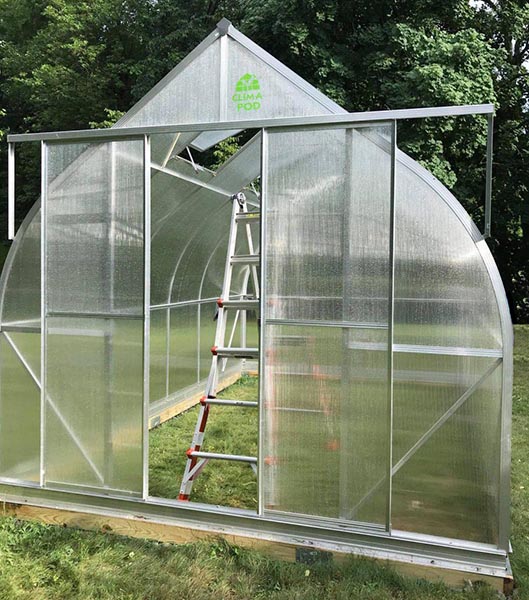Polycarbonate greenhouses accumulate heat and create a favorable microclimate for plants. But without temperature control, there is a risk of overheating and air stagnation, and this poses a serious danger to greenhouse crops. Let’s figure out what a draft is and why it is dangerous for your greenhouse. And also how to organize proper ventilation in a polycarbonate greenhouse.
Why ventilate a polycarbonate greenhouse?
Stale air slows down the growth and development of seedlings and provokes the proliferation of pathogens and pests. On the hottest days, the heat inside the structure can destroy plants.
Ventilation, which performs several functions, will help you avoid an unpleasant situation:
- provides fresh air into the greenhouse;
- reduces room temperature, preventing overheating;
- eliminates high humidity;
- increases plant resistance to negative environmental factors;
- facilitates the fight against harmful insects and diseases;
- improves pollination.
The difference between ventilation and draft

These two processes are similar from a physical point of view, since they are characterized by the movement and replacement of air. But they also have significant differences.
A draft is a flow of air that blows through a room through openings that are located opposite each other. This is a “room wind” that occurs when doors or windows in opposite parts of the greenhouse are opened at the same time. In this case, uncontrolled air exchange occurs.
Ventilation is natural air exchange that does not require additional effort. This is done by opening the windows located on one side of the greenhouse. In this case, air flow circulation should be created throughout the entire area of the room.
Why should you avoid drafts in Your greenhouse?
Despite the fact that both procedures provide air replacement, ventilation is necessary for plantings, and drafts are harmful to them. It disrupts the microclimate around plants and replaces moisture-saturated air with dry air. As a result, the evaporation process is activated, which leads to drooping and wilting of the leaves. In addition, a draft causes a sharp temperature change, which causes thermal shock in plants. This can cause even the most unpretentious greenhouse crops to catch cold.
Please note! A draft is especially dangerous if the air flow speed exceeds 1 meter per second.
What plants are afraid of drafts in a polycarbonate greenhouse?
Different cultures have different requirements for temperature, humidity, and ventilation. They also treat drafts differently.
Cucumbers
For normal development and fruiting, cucumbers need warmth and humidity. They feel great even in stagnant air and do not tolerate drafts at all. To prevent the development of diseases, regularly ventilate the greenhouse using vents on the door or roof.
Peppers and eggplants
These crops tolerate temporary drops in temperature and stagnant air, but are very afraid of drafts. Peppers and eggplants are ventilated using vents on the roof of the greenhouse.
Tomatoes
Tomatoes, unlike other greenhouse crops, prefer coolness and a light draft. They absolutely cannot tolerate stagnant air, because in such conditions late blight actively develops, and the pollen becomes sterile and fruits are not set. Ventilate the greenhouse with tomatoes regularly, and in hot weather leave the doors wide open.
Morning, afternoon, evening: when and how to ventilate Your greenhouse

To prevent overheating and death of plants on hot sunny days, the polycarbonate greenhouse is ventilated several times a day. The optimal time is from 11 AM to 3 PM. In hot, windless weather, open windows and doors at the same time to cause at least a slight movement of air. In cloudy weather, ventilation is limited, but not canceled. If the air temperature outside has dropped significantly (to 50 °F), then ventilate the room for no more than two hours – from 12 AM to 2 PM.
In the morning, the greenhouse is ventilated after sunrise, when the temperature inside the structure rises. In this case, condensation will not form, which provokes the development of fungal diseases.
Do not ventilate the greenhouse after sunset to avoid heat loss at night.
There is no need to cover the plants before airing. They are not in danger of catching a cold. But condensation formed under the cover will harm greenhouse crops.
Ventilation of a large and small greenhouse – are there any differences?
Small compact buildings are much easier to ventilate. Windows, regardless of location and quantity, will fully do their job.
In a large greenhouse (more than 25 feet long), especially one divided by a partition, even with the end doors open, the air coming from outside will not be enough. Therefore, for such structures, vents are required, which should be located along the entire length of the construction.
In addition to the length, the speed of movement of air masses is also affected by the width of the greenhouse. In a wide polycarbonate greenhouse (more than 9 feet), you can create passages free from plants, which will allow air to move without difficulty. In narrow rooms, plants occupy almost the entire space, creating a natural barrier to air circulation.
For a backyard, a greenhouse that is up to 21 feet long and 7 to 9 feet wide is considered a good option. This provides optimal conditions for placing your plants.

Vents are installed in the upper part of the greenhouse – this is where hot air accumulates. In long buildings, it is advisable to make windows on the side walls (preferably at different heights). The number of vents is calculated depending on the area of the greenhouse. It is recommended to install one window for every 7 feet.
Please note! Greenhouses surrounded by large, dense trees or other buildings will require more vents than structures located in well-ventilated, elevated areas.
For farm greenhouses over 14 feet wide, fans are installed at the ends.
How to automate ventilation in a polycarbonate greenhouse?
In most cases, gardeners use manual ventilation. But not everyone has the opportunity to constantly be near the greenhouse in order to regularly open and close doors and vents. In this case, automatic openers will come to the rescue. They are installed on a door or window. Under the influence of temperature, the composition located in the cylinder body expands and pushes out the rod, due to which the opening occurs. As the temperature drops, the composition contracts and the window closes. This mechanical device does not require any power source.
Automatic thermal drive ensures natural air circulation and maintains a stable temperature in a polycarbonate greenhouse around the clock.

